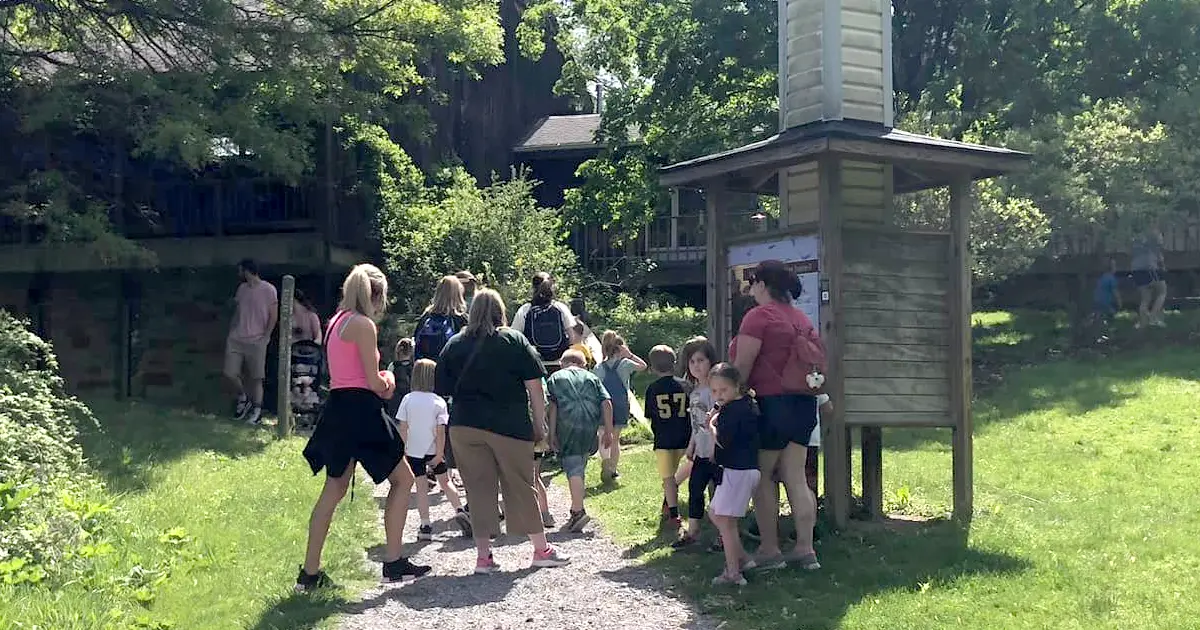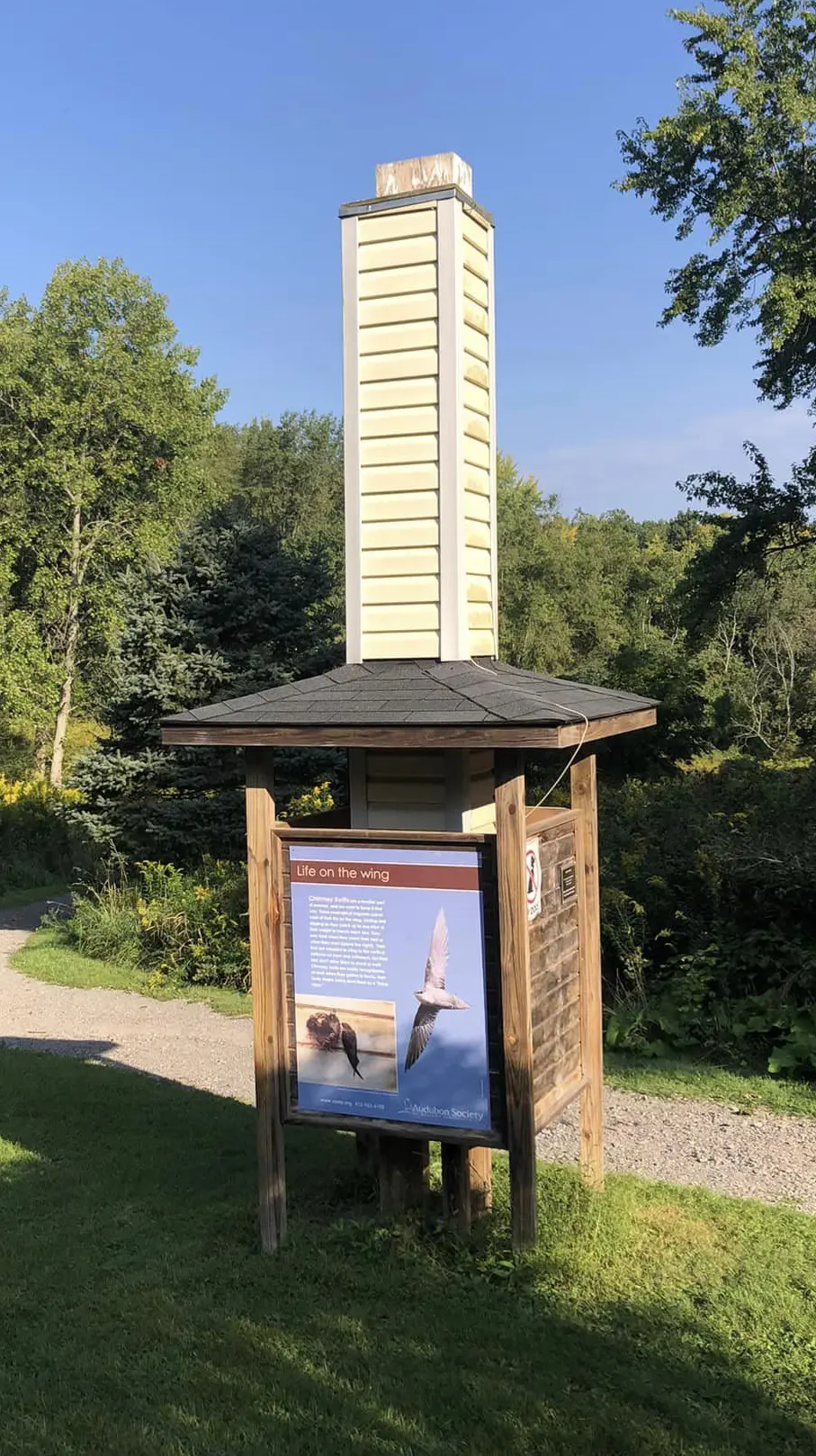ASWP has created the largest concentration of “purpose-built” Chimney Swift habitats on the continent.

Chimney Swift conservation
Audubon Society of Western Pennsylvania supports Chimney Swift conservation by providing the birds with nearly 150 Chimney Swift towers – breeding habitats for these acrobatic birds. We monitor tower usage to get a picture of bird populations in our area. Through our education initiatives, we are working to spread awareness of the importance of Chimney Swift conservation and how individuals can support their protection.
If you know of Chimney Swift tower or pre-migration roost,
please email info@aswp.org to add it to our database.
About Chimney Swifts
Why are these birds important?
In 2018, Chimney Swifts’ threat level was upgraded from Near Threatened to Vulnerable by the IUCN Redlist. Over the last 50 years, their population has declined more than 70%. In recent years, the rate of decline has accelerated. Their decline is attributed to a decreased availability of insects (their food source), shifts in chimney design, and the capping and demolition of chimneys. A majority of other aerial insectivores are experiencing a similar drastic population decline.
What do they look like?
Chimney Swifts, often described as ‘cigars with wings,’ spend a majority of their life in flight. They are small smudge-gray birds that consume thousands of airborne insects a day. While not in flight, Chimney Swifts cling to vertical surfaces using spines on the end of their tail feathers to help support them. Chimney Swifts are unable to perch on a branch like other birds. Historically, these birds nested in hollowed limbs, snags, and even in caves. As cities became more common and mature trees became less common, Chimney Swifts adapted to roosting and nesting in chimneys.
When do they nest?
Chimney Swifts typically nest during June and July. Look for them flying over towns and neighborhoods or listen for their twittering calls.
ASWP’s Chimney Swift Towers

Chimney Swift Towers are unique structures that mimic an actual chimney, serving as roosting and nesting habitat for the birds. The central tower is constructed much like a traditional chimney and the interior walls of the tower provide roosting and nesting opportunities. Most of these structures also feature an exterior kiosk which contains educational information about Chimney Swifts.
Chimney Swifts will not allow other birds (including swifts) to use the tower while they are nesting. While a Chimney Swift Tower could be used as a roost by 100+ birds during migration, a single pair of birds will use the structure during the nesting season. Each tower is critical in supporting the birds! Look for our Chimney Swift towers in municipal parks, county parks, and school grounds near your home.
Where are the Chimney Swift Towers located?
There are more than 100 Chimney Swift towers throughout the nine Allegheny County Parks thanks to a partnership with the Allegheny County Parks Foundation, Allegheny County, and Peaceable Kingdom Fund of The Pittsburgh Foundation. North Park has 22 towers, South Park has 19, Deer Lakes has 12, Settlers Cabin has seven, and the remaining county parks (Harrison Hills, Boyce Park, Round Hill, White Oak) each have eight towers.
We partnered with Millvale Borough to install four towers along the riverfront trail, in the Gardens of Millvale Community Garden, and at the Millvale Ballfield – thanks to generous funding from the Sprout Fund. There’s also a tower at Shaler Area High School that’s provided learning opportunities for the school’s students.
Scout Service Project towers
Eagle Scout Service Projects are an opportunity for scouts to develop leadership skills on projects that provide community benefit. Through this partnership, more than 30 Chimney Swift towers have been added to the region in places such as O’Hara Township Community Park and Richland Park. Through the generous support of the Jordan Foundation, Audubon is able to provide educational panels and partial material reimbursement costs for each one of these towers. If you are an Eagle Scout interested in building a Chimney Swift tower, email Brian at bshema@aswp.org for more information.
Did you know ASWP offers scouting opportunities? Check out Scouting at ASWP
Chimney Swift FAQ
Chimney Swifts are neo-tropical migrants that typically arrive in western Pennsylvania during the third week of April and leave around the first week of October. Chimney Swifts migrate in large groups, ranging from six to 20 birds to thousands of birds. They often mate for life and do not allow other birds in their chimneys during mating and nesting.
How can I identify a Chimney Swift?
Chimney Swifts are often described as looking like ‘cigars with wings.’ They’re small aerodynamic birds that spend a majority of their life in flight. When they aren’t flying, they cling to vertical surfaces using spines on the end of their tail feathers–they are unable to perch on a branch like other birds. They have an approximate length of 5” and wingspan of 11”. Males and females do not have a distinctly different appearance; both are a smudge-gray color. Parents share the responsibility of feeding the nestlings and can be seen entering and exiting the nesting site throughout the day.
How can I tell the difference between a Chimney Swift and a bat?
Both bats and Chimney Swifts are important parts of our environment and eat insects. The Chimney Swift call is very distinctive and can be heard from a great distance while most sounds that bats make are undetectable by humans in the outdoors. Chimney Swifts also fly at a much higher elevation than bats do. And bats become active in the evening while Chimney Swifts enter the roost at dusk to settle in for the night.
What do Chimney Swifts sound like?
Listen to them on All About Birds website.
What do Chimney Swifts eat?
They eat insects – and a lot of them. One bird can eat up to 5,000 to 6,000 insects per day.
What type of birds are Chimney Swifts related to?
As part of the Apodidae family, Chimney Swifts (Chaetura pelagica) are related to hummingbirds.
What is their range?
Chimney Swifts are neo-tropical migrants that overwinter in the Amazon basin in South America. They begin to arrive in North America in late spring and are found in the eastern portion of the United States and southeastern portion of Canada.
What type of habitat do they live in?
Chimney Swifts historically used limbs, snags, and caves for roosting and nesting but have adapted to use chimneys for these purposes. Swifts are common in cities, neighborhoods, and towns where there are chimneys present. Chimney roosts can be used by groups of birds that can reach numbers in the hundreds or even thousands. Using chimneys during migration allows swifts to conserve heat and avoid exposure.
Are Chimney Swifts threatened?
Although still relatively common, Chimney Swifts have been designated as Near Threatened since 2010. A State of the Birds Report (2014, Nature Conservancy) lists Chimney Swifts as a Common Bird in Steep Decline, having experienced a 70%+ decline over the last 50 years. The birds’ decline is attributed to a shift in chimney design, the capping and demolition of chimneys, and a decreased availability of food sources (insects) due to widespread use of pesticides.
What should I do if Chimney Swifts are in my chimney?
Chimney Swifts are protected under the Migratory Bird Treaty Act. Disturbing birds, eggs, or nests that may contain eggs is illegal. If Chimney Swifts have moved into your chimney, there is no reason to worry. They will not cause any damage and will stay only temporarily.
How can I help to support Chimney Swift conservation?
If you have a chimney, leave it uncapped and have it cleaned in March, after the winter use but before Chimney Swifts arrive in our area. If your chimney has already been capped or your house doesn’t have a chimney, consider building a Chimney Swift tower. In order to help ensure that swifts have plenty of food, consider reducing or eliminating pesticide use. Another great option is to donate to Audubon Society of Western Pennsylvania to support our Chimney Swift conservation efforts.
I’ve identified a nesting location; who should I contact?
Please email the location to info@aswp.org so it can be added to our Chimney Swift map and monitoring program.
Can I build or register my own tower?
Yes! If you’d like more information on building your own Chimney Swift tower or if you’d like to partner with us to further our Chimney Swift tower initiative, please contact us at info@aswp.org.
Report what you see at Chimney Swift Towers
You can help us by reporting what you’re seeing at Chimney Swift towers (and natural chimneys), even if you see no birds, please let us know!









